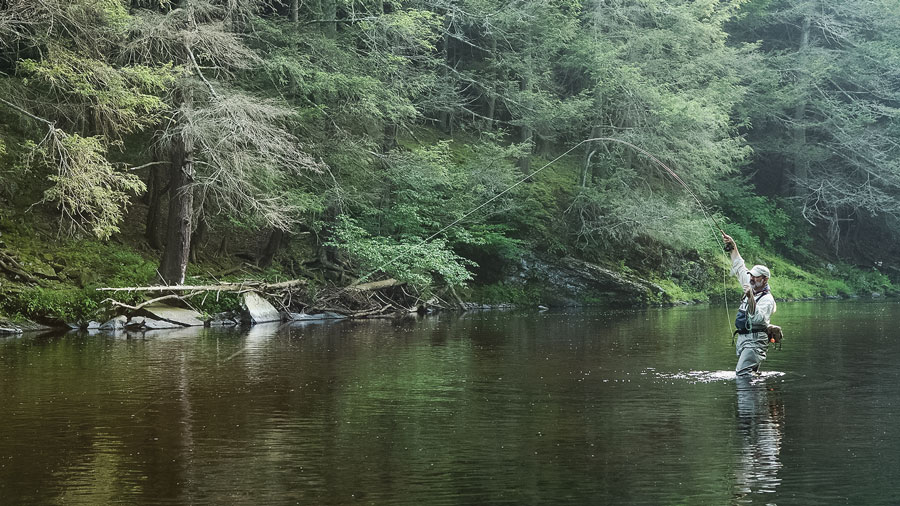
For the third time in as many minutes the trout rose under the shadow cast by the low-hanging branches of a maple tree. The subtle disturbance could easily be mistaken for a minnow or pumpkinseed, maybe a nymph breaking the surface to emerge into an adult mayfly. No loud splash, not even the usual concentric circles, only the briefest of dimples to betray the fish’s presence.
As August progresses, the water on this slow-moving run has become as thin as my aging hairline. Trout that have survived a season of anglers, not to mention mergansers, herons, snakes, and otters, fin in the gin-clear current like specters through a graveyard, mocking any attempt to prove their existence. All the while they grow large on the stream’s abundant insect life as evidenced by this fish, which continues to feed where I lost a trout the previous afternoon. Yesterday, another fish rose through the surface to grab my fly, but when the knot between a 7x tippet and the end of my leader failed to hold, it broke me off.
Taking my time, I now cross the wide pool a few hundred yards below the maple tree. I take even longer to wade upstream, crouching twenty feet below the phantom riser that continues to devour insects only inches from the far bank. For a moment the fish stays down, or perhaps it’s a trick of the shadows, but then the telltale disturbance returns, almost imperceptibly, as if I can feel the rise rather than see it.
Having replaced the tippet that snapped off the previous afternoon, I look through my fly box and decide upon a fly with a dun-colored wing and a body spun from beaver fur dyed dark olive. It’s a pattern similar to the one that fooled the fish the previous day. The tiny imitation of a late-season blue-winged olive mayfly is no bigger than the letter o typed on this page. The wing is wrapped around the tiniest of white posts that is barely visible from where I’m crouching. Tied in what is called a parachute style, it provides a low profile against the water’s surface.
With a long leader and fine tippet, my cast brings the pattern a foot or so above the trout’s feeding lane. I wait for the fish to connect, my muscles tense, eyes focused, but the dimple appears only after the olive fly has passed by.
Sometimes casting to a selective trout can be like pitching to a batter. Like going inside to get the hitter’s attention and then throwing heat down the middle on the next pitch. When a fish fails to respond to your offering, a standard fly-fishing maxim is to go a size smaller, and after a few more casts I do just that. But the fish digs in its fins, continuing to feed as the damn dimple mocks my efforts to prevail.
Looking closely, I spot a few olives on the water. Their wings lie flush with the surface. I tie on a pattern meant to imitate a spent mayfly, one that has died after mating. The wings of this pattern mimic those of the insects floating under the maple tree. Predictably, the fish ignores it. Fly fishing, like baseball, is not as easy as it might appear.
No worries. I switch to a pattern known as an emerger. Same insect, different stage, a fly created to simulate an aquatic insect as it “emerges” through the surface. It’s a pitch that is tough for a batter to lay off, even a trout as selective as the late Thurman Munson.
The fish follows. I watch it rise, but then it falls back, letting my offer drift across the plate.
If your best pitch fails to work, use it to set up the next one. Having run the count full, the challenge is to find the right fly before the multiple casts put the fish down, the equivalent of walking the batter.
I snip off the emerger and tie on a terrestrial. Not a small one, but an imitation of a big, fat, black ant, about as different from the tiny olive imitations as anything you might find on the water this time of year. Think of it as my version of an Eephus pitch.
With one chance to get it right, I wade a few steps closer. Shuffling slowly, I hope to avoid disturbing the stream bottom that might alert the trout to my presence. The ant drifts down the middle of the plate until the dimple surrounds its greased hackles. A momentary suspension in time is broken when the fish erupts through the surface, sunlight glistening off nickel-size pumpkin spots.
It’s only later, while removing the black ant from the corner of the big brown’s jaw that I discover the second fly, a #20, blue-winged olive, with a length of 7x tippet still knotted to the eye of the hook.
If you’d like to read more about Bonnie Brook and the natural world out your back door check out Bob’s website: forgottentrout.com where there is a link to his blog.